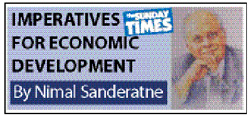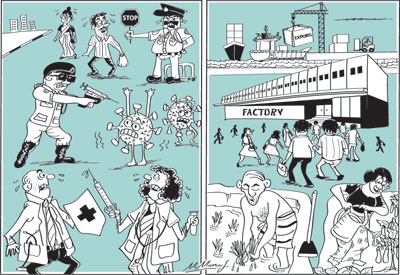Columns
Containing COVID-19 and getting the economy moving
View(s): Containing COVID-19 while getting the economy functioning again is a challenging task. In as much as containing COVID-19 is vital for the safety of lives and livelihoods, the functioning of the economy in tandem with COVID are vital for the livelihood of people.
Containing COVID-19 while getting the economy functioning again is a challenging task. In as much as containing COVID-19 is vital for the safety of lives and livelihoods, the functioning of the economy in tandem with COVID are vital for the livelihood of people.
Economic necessity
The shutting down of economic activities to contain the virus is a threat to the livelihood of people, especially those with low income and daily wages. The Government has therefore chosen to open the economy as much as possible, while adopting measures to control COVID and provide food and income to those in locked down areas.
Balancing act
Each of these tasks are tough tasks that have to be done for the life of the nation. Doing both in tandem is a balancing act fraught with the risk of COVID spreading and increasing shutdowns and lockdowns that will in turn affect the economy and peoples’ livelihood.
This policy of containing the virus with only a limited economic shutdown, though fraught with danger, is unavoidable. Managing this balancing act requires a multiplicity of skills, dedication and most of all a sense of social responsibility by people. The medical professionals and paramedics, the administration, the army and the police have daunting tasks to perform. All those who have contributed to the success deserve the plaudits of the nation.
Risks
Much remains to be done to contain the virus. The tasks are getting more difficult as the virus keeps spreading further. It is no longer clusters that are affected, as the virus has spread in many areas. The return of an increasing number of Sri Lankans from foreign countries and a mass scale breach of health guidelines pose serious threats.
 Focus on the economy
Focus on the economy
How best can the Sri Lankan economy perform while adopting adequate measures to prevent the virus spreading? How best can the economy function to increase the production of goods and services and to ensure adequate export earnings to reduce the trade deficit? What are the ways and means by which the economy can function while COVID is spreading?
Strategies
There are three ways by which the economy could function with the least disruption.
First, those economic activities that are least affected by COVID should perform at the maximum level of production. These activities include, cultivation of food crops, tree crops and export crops and small scale cottage type industries.
Second, export manufactures that have been adversely affected by diminished global demand should produce new export commodities that have an international demand by deploying their production capacities to produce goods that are in demand internationally.
Third, manufactures of goods and services that have a domestic demand should expand their production and enhance import substitution.
Long run
While the ways and means of ensuring the economy functions at its maximum potential under the current constraints of COVIDare implemented, policies to increase production in the long run must not be neglected. This is especially so with respect to the main tree crops – tea, rubber and coconut – as well as cocoa, cashew, coffee and fruits.
First strategy
The economic activities least affected by COVID, such as the cultivation of food crops and export crops, small scale craft making and household goods production, should maximise production.
The constraints to food crop production such as the unavailability of fertiliser and seed materials, as well as difficulties in marketing of produce, have to be resolved to ensure higher production of these crops.
The threat of animal damage is another obstacle that has to be eliminated.A good Maha harvest early next year would certainly improve the livelihood of people.
Fisheries
The country’s fishing output could be increased in spite of the prevailing conditions. Improving the marketing of fish for domestic consumption and increasing sea food exports could contribute much to the economy and peoples’ livelihood.
Tea
At the same time long term development of agriculture should not be neglected. The long term strategies for tea include, the replanting of senile tea and vacancies in tea plantations with high yielding VP (vegetative propagated) teas.
Research
Strengthening the capacity of tea, rubber and coconut research institutes and appropriate incentives for increasing investment for long term production are vital to increase production of these crops. The area cultivated in rubber and coconut should be expanded. The Rubber Master Plan that has hardly been implemented in the last two years, should be effectively implemented to increase natural rubber for manufactures.
Small industries
Those economic activities that are the least affected by COVID should continue their production where possible and diversify to new products in demand. However, the constraints to their expansion are the depressed demand for some crafts and the unavailability of needed raw materials.
Industrial exports
The country’s main industrial exports of apparel, tyres, rubber goods, ceramics and other consumer durables have been seriously affected by a fall in global demand. Nevertheless, the adaptability of several export industries to new international demands have beena significant success.
The apparel industry has switched to the manufacture of personal protection equipment (PPE) such as masks. Rubber manufacturers have adapted to produce PPE items such as rubber gloves and surgical gloves. These have compensated for the loss in international demand for solid tires and other rubber products.
Consequently manufactured export earnings have been at around the same level of US$ one billion a month as before COVID affected exports.
Important
The Government’s measures to ensure that workers in export processing zone are able to work is important to keep the wheels of manufacturing ensuring industries functioning. The current challenge lies in ensuring that these industries are able to perform at full capacity in spite of the pandemic.
Services
There has been a dip in demand for ICT services abroad. However the global demand for these services is likely to revive faster than for the country’s manufactured exports. The infrastructure of ICT services should be prepared to seize new opportunities in this field.
Tourism
International travel and tourism has been the worst affected, globally and in Sri Lanka. International tourism is likely to revive at the end of 2021, at best. Therefore there should be efforts to revive domestic tourism in a cautious manner.
Concluding reflection
There are no signs of an early eradication of COVID globally, though there is some hope that the vaccines produced would be available sooner than earlier expected. In as far as Sri Lanka is concerned the economy would have to perform under the constraints imposed by the pandemic and the island’s efforts to contain COVID.
Increasing production in agriculture, fisheries and manufactures that are the least affected by the prevailing conditions are vital for the economy and the wellbeing of the people.


Leave a Reply
Post Comment